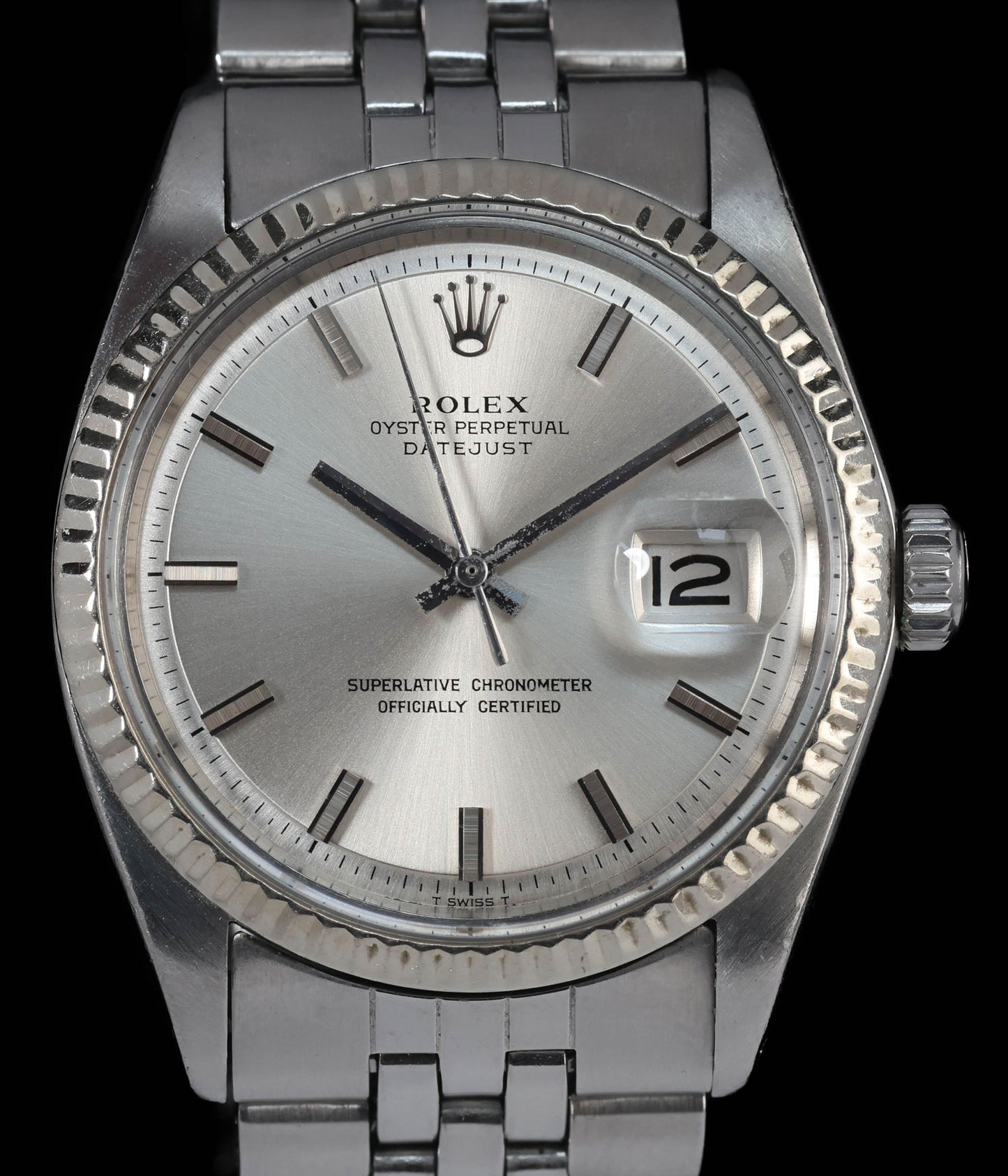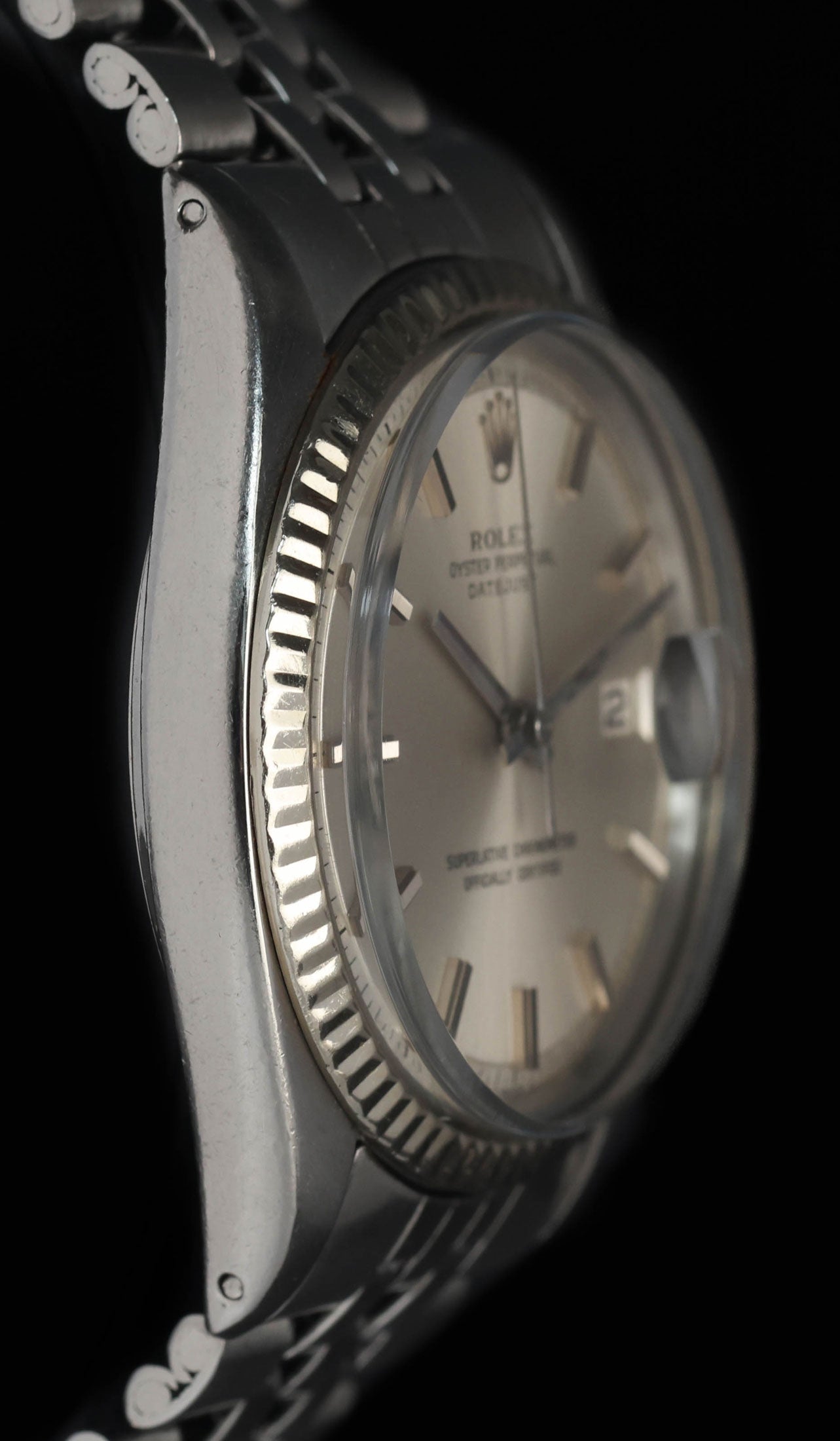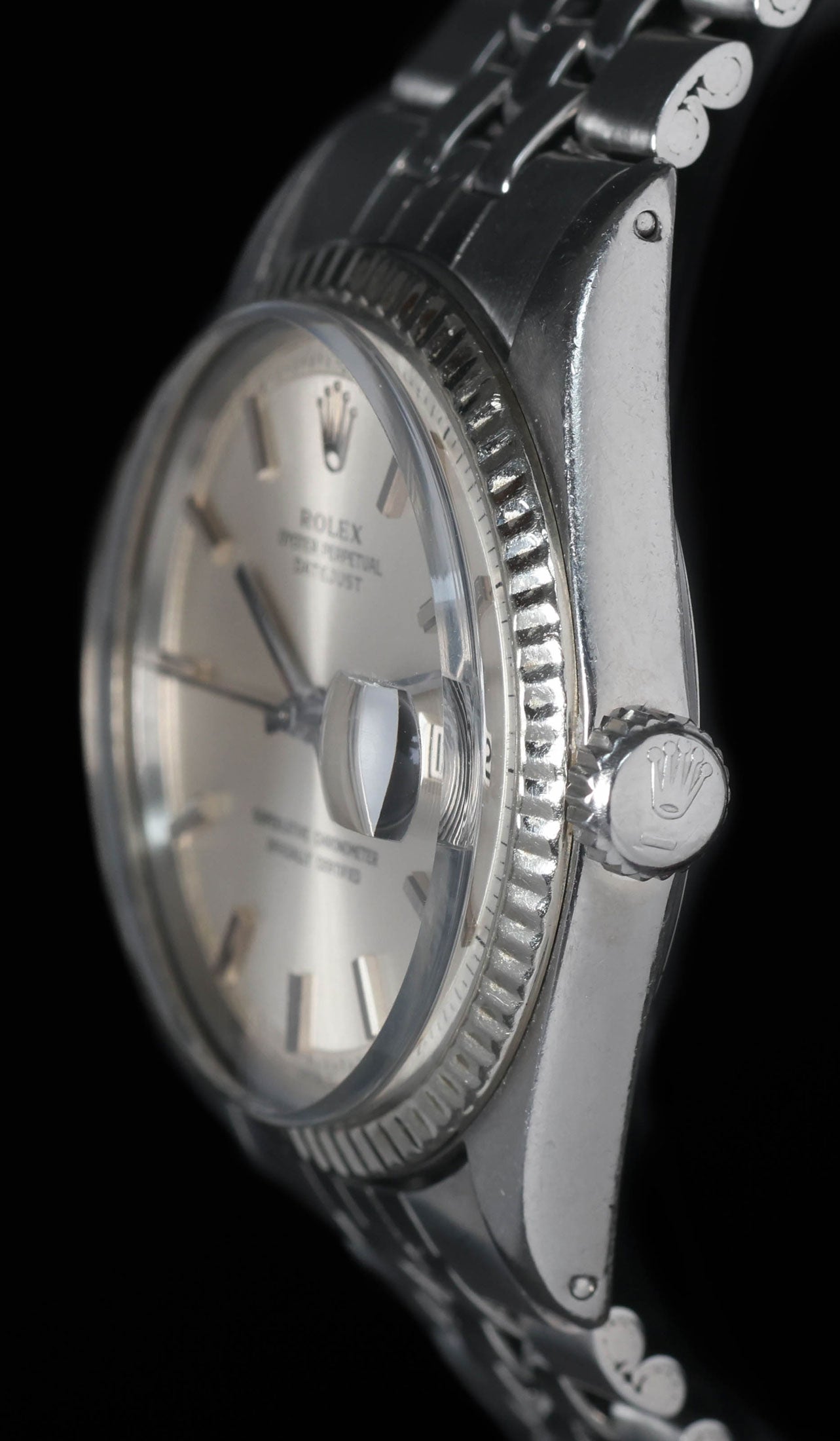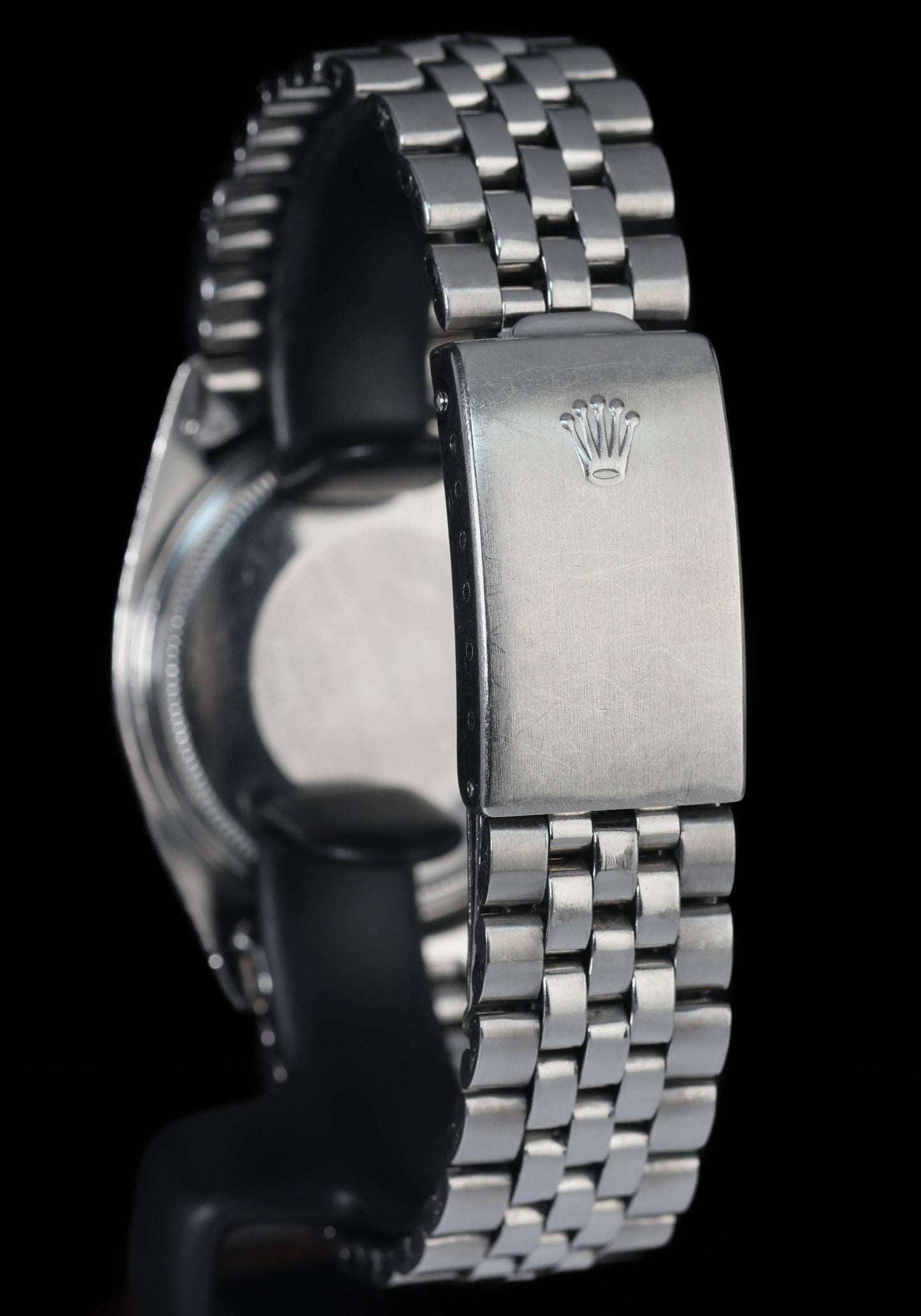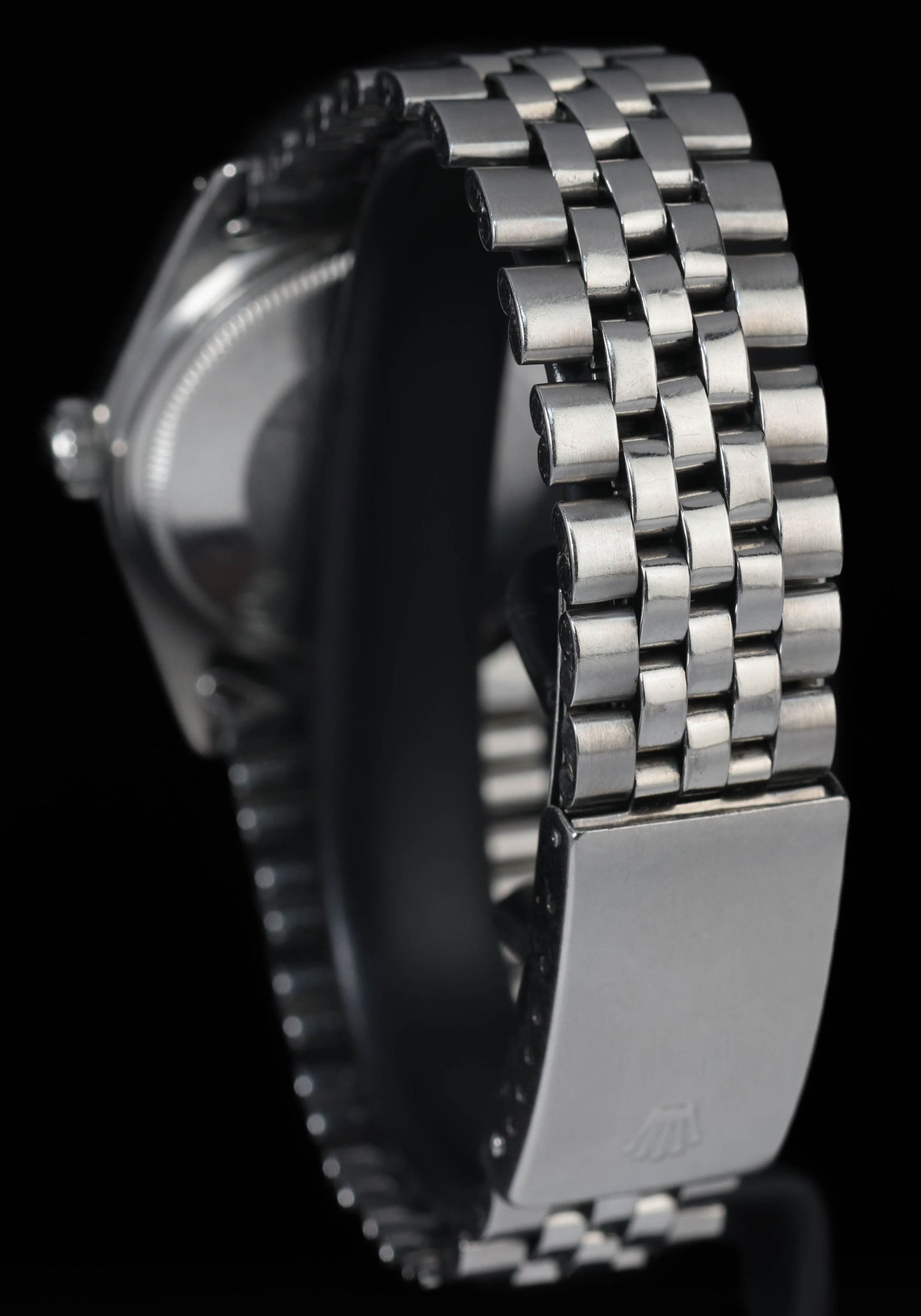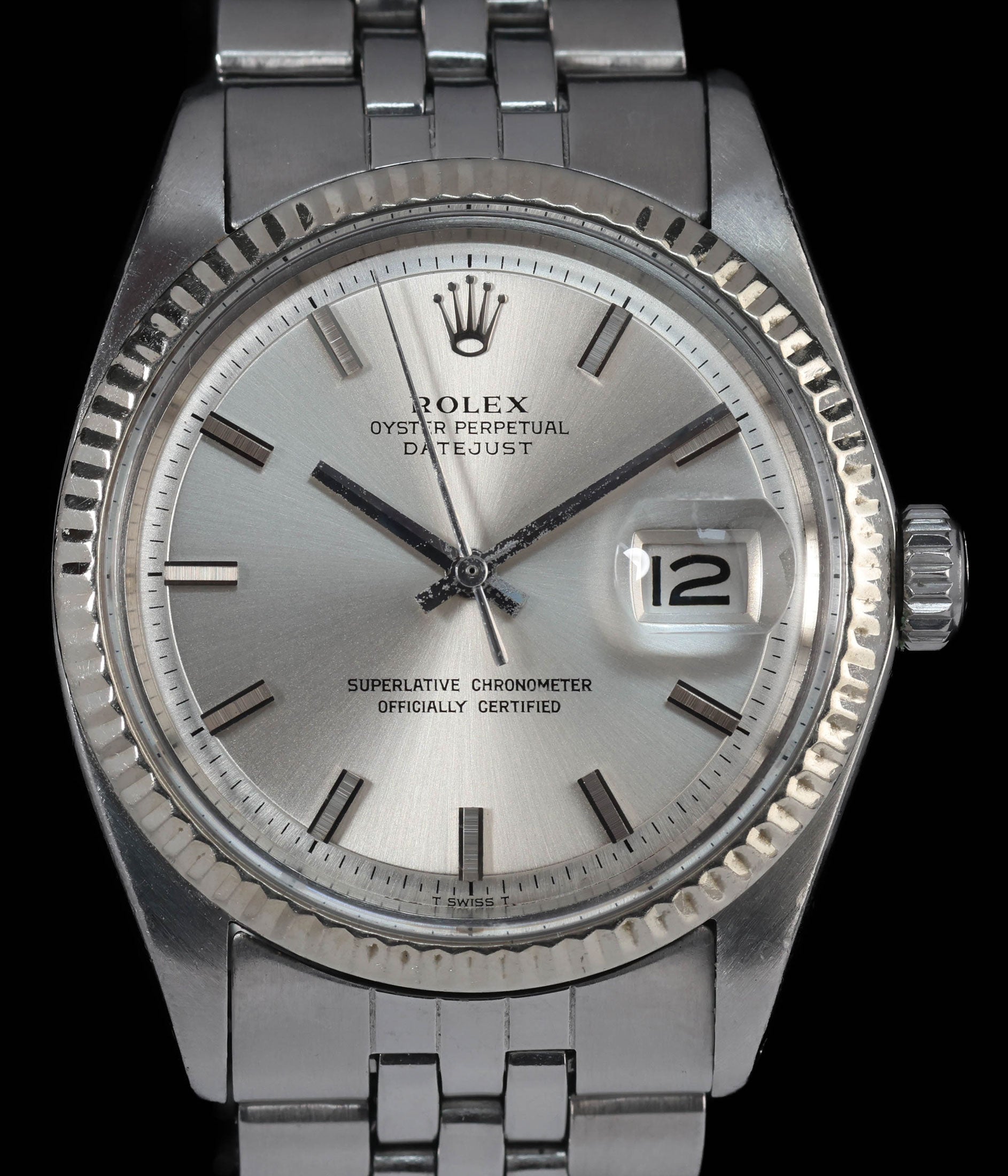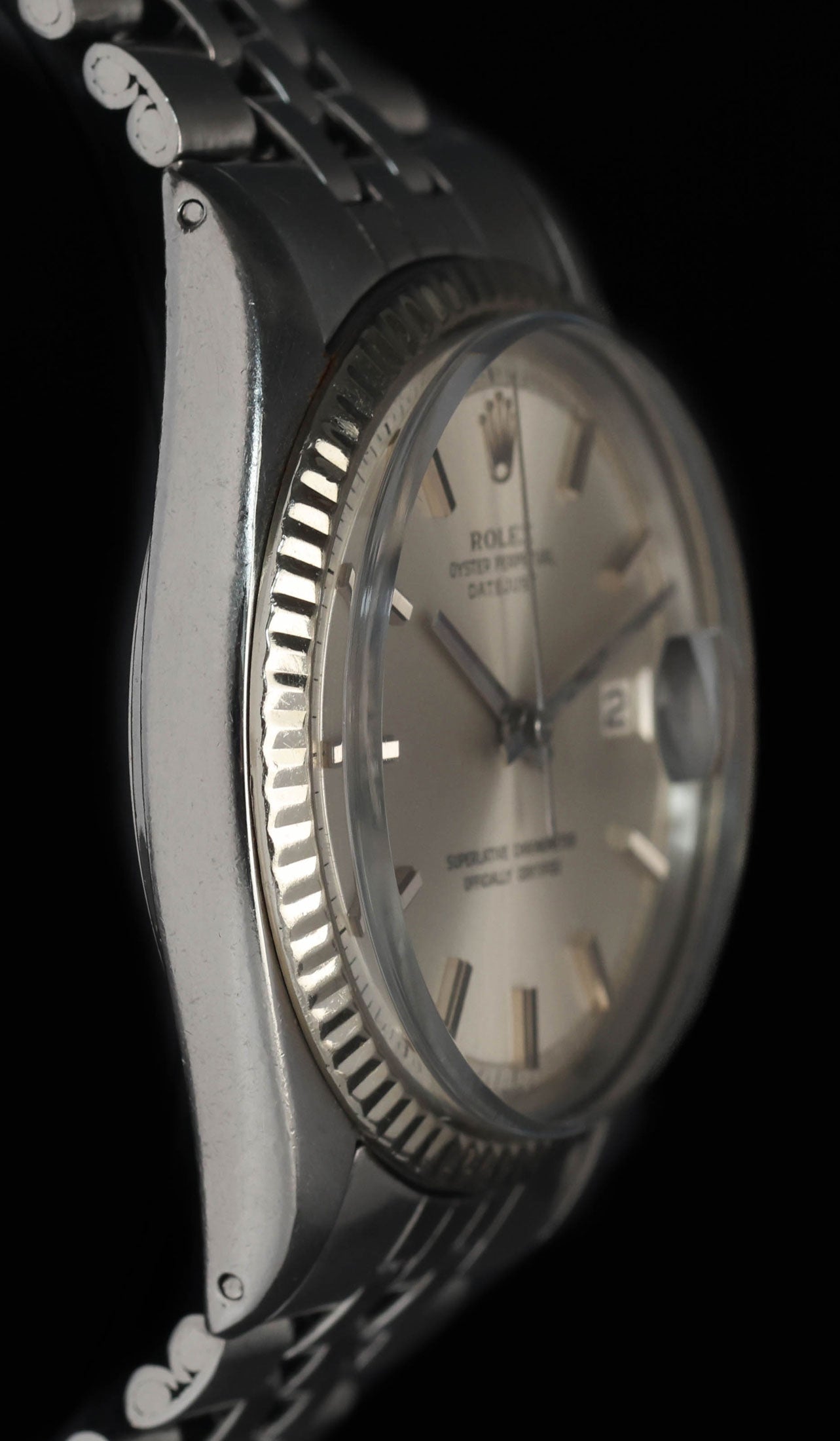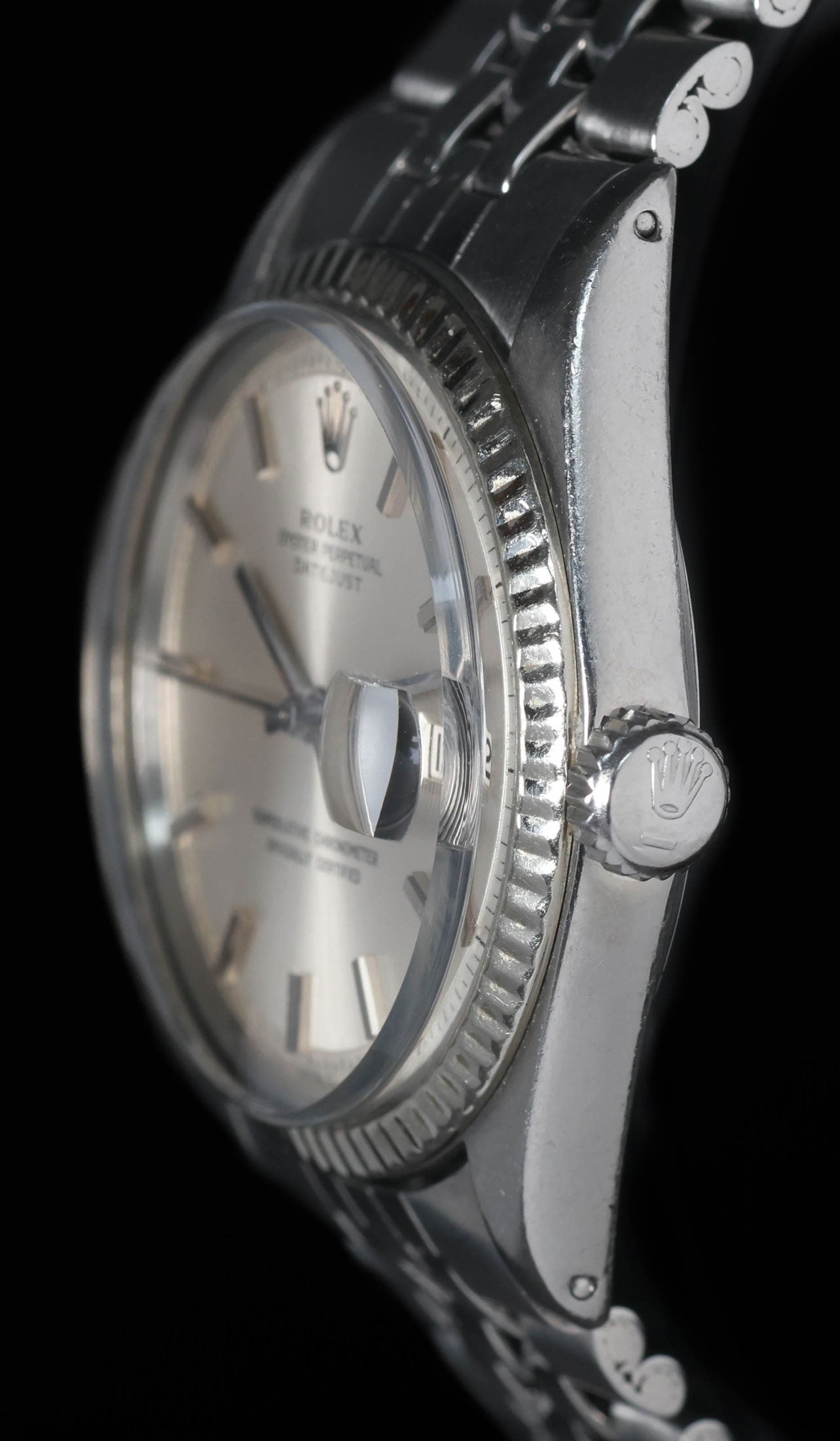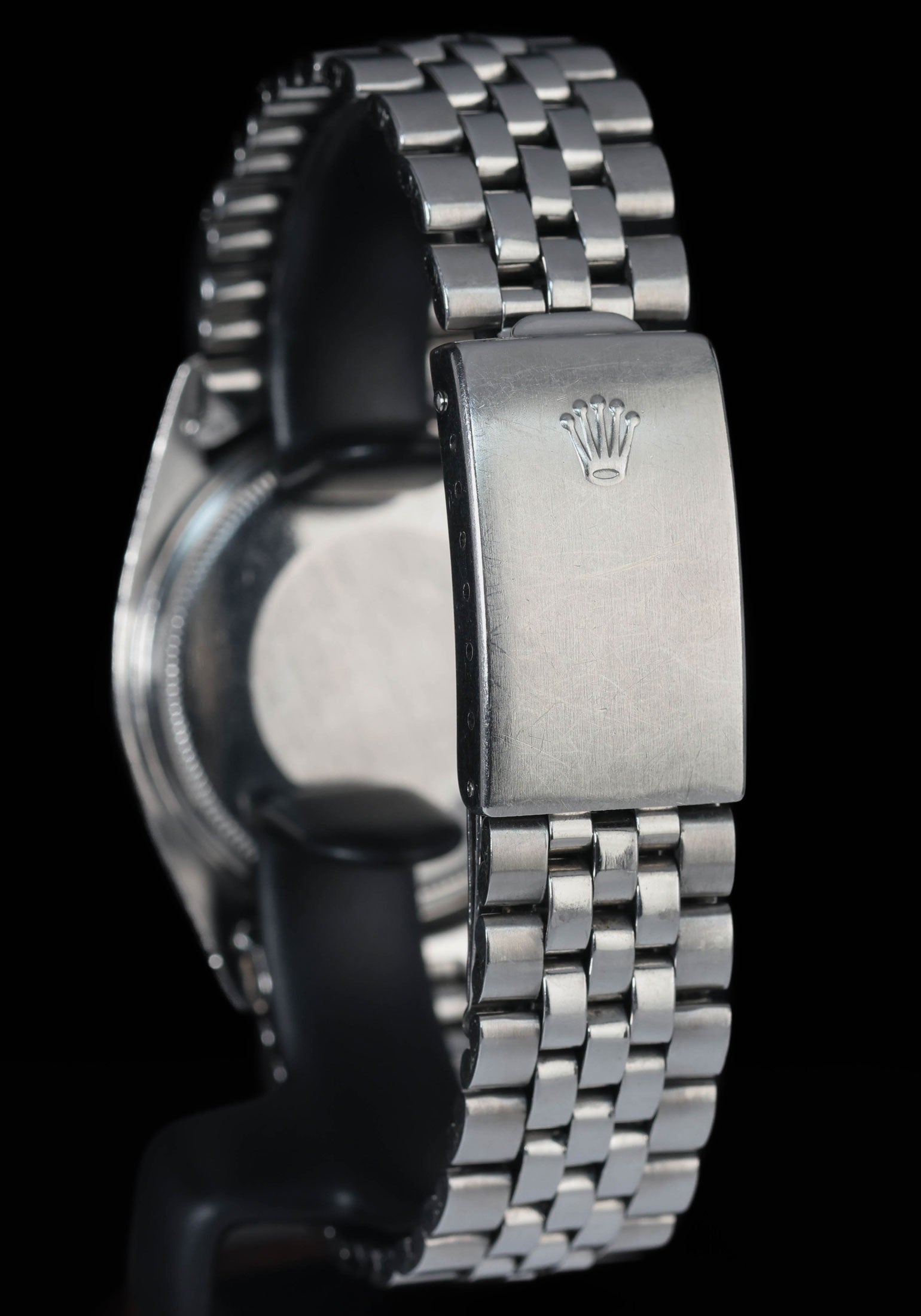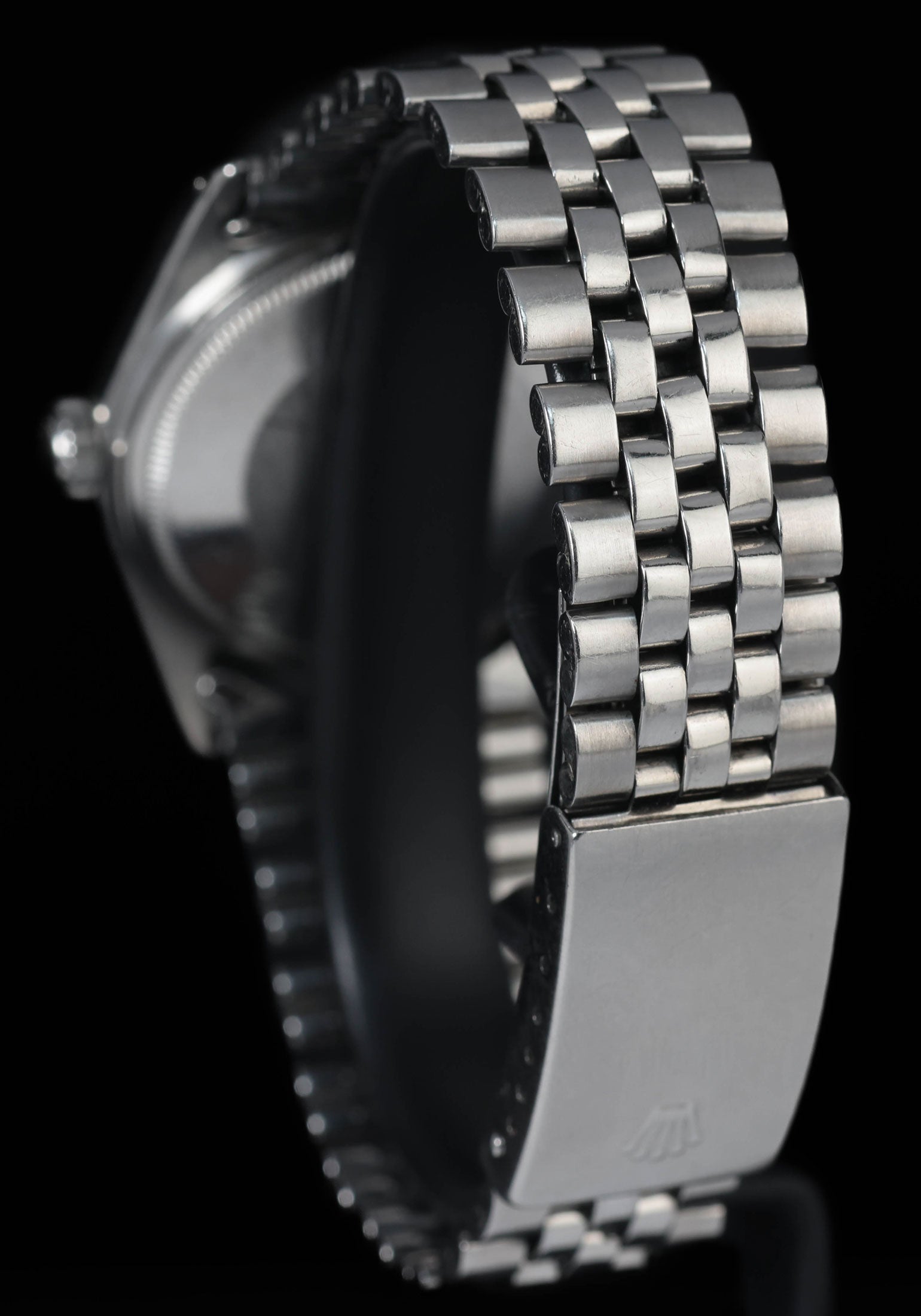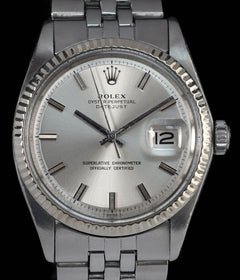Crown Vintage
Rolex Datejust 1601 'Non-Lume' 36MM 1972
Rolex Datejust 1601 'Non-Lume' 36MM 1972
Couldn't load pickup availability
Rolex Datejust 1601 'Non-Lume' 1972
Case retains original lines with visible hairline scratches in keeping with general age. Bracelet remains tight and well-preserved for its age, showing minor surface marks. Dial is clean and even, all printing intact. Hands display slight oxidation but remain structurally sound. Overall, a well-kept vintage example with honest age-appropriate wear.
Share
Why we love this watch
Why we love this watch
A quiet pivot in the Datejust story
By the early-1970s Rolex had already spent a quarter-century fine-tuning the Datejust formula: a waterproof Oyster case, an automatic chronometer movement and a date that switched precisely at midnight. What changed in 1972 was not the technical bedrock but the aesthetic handwriting on certain dials. Among them sits the Rolex Datejust 1601 with non-luminous hands and markers—an apparently small deviation that reveals much about shifting tastes, evolving regulations and Rolex’s willingness to adapt without fanfare. Looking beyond the lume dots that normally punctuate a Datejust dial exposes the model’s design in its purest form and underlines why the reference still feels fresh half a century on.
From Jubilee year to fluted bezels
The Datejust line began in 1945, ushering in Rolex’s self-winding calibre 740 and the now-standard date aperture at three o’clock under a magnifying cyclops. Over the next three decades the case settled at 36 mm, the movement advanced to higher beat rates, and the fluted bezel in solid white gold became a signature dressing up the otherwise utilitarian steel exterior. The reference 1601, introduced in the late-1960s, crystallised these traits: a 36 mm stainless-steel Oyster case, a sharply faceted bezel, a Jubilee bracelet tapering from 20 mm lugs, and an acrylic crystal that rose just enough to catch the light.
The example under discussion omits lume altogether, leaving the silver sunburst dial free of the familiar tritium plots. In a period when concerns about radium had already pushed watch brands toward lower-activity tritium, Rolex also produced dials for markets or owners who preferred a cleaner, radiation-free layout. The result is a pared-back rendition that lets the applied hour markers and stick hands stand proud against the dial’s brushed texture.
Case engineering and proportions
Even measured against twenty-first-century sports pieces, the Oyster case feels disciplined. At 36 mm in diameter and around 11.5 mm thick, it slips easily under a cuff without sacrificing the block-like solidity Rolex achieved with its patented screw-down crown and threaded back. Twin internal gaskets support 50 metres of water resistance—adequate for rain and the occasional swim, if not deep-sea adventure. The mid-case flares subtly at the lugs, creating a pronounced shoulder that anchors the Jubilee bracelet’s first solid end-links. Polished flanks contrast with brushed lugs, a deliberate play of finishes that breaks up the visual mass.
The white-gold bezel is more than ornament. Its fluting provides a grip for watchmakers when removing the crystal and securing the case seal. On the wrist, the bezel’s ridges catch ambient light and lend a touch of formality that an engine-turned or smooth bezel cannot match. While the bezel metal can pick up shallow nicks over decades, gold’s resistance to corrosion ensures the facets stay bright with ordinary care.
Movement: calibre 1575
Inside ticks the self-winding calibre 1575, a 26-jewel chronometer running at 19,800 vph. It descends from the 1500-series architecture that Rolex began rolling out in 1957, bringing a free-sprung Microstella balance, a Breguet overcoil hairspring and hacking seconds. Though it lacks the rapid-set date introduced in later references, the movement’s 48-hour power reserve and stable chronometry have earned a reputation for longevity; parts interchangeability within the 1500-series means competent watchmakers can still source wheels, levers and balance staffs without resorting to cannibalising donor movements.
The automatic winding rotor spins on a jewelled centre bearing rather than the early tweezer-style caged assembly, reducing service wear. Bidirectional winding gears translate wrist motion into mainspring torque with little mechanical chatter, and a substantial mainspring barrel delivers consistent amplitude until the final hours of reserve. For travelling owners, the lack of quick-set means advancing the date requires cycling the hour hand through midnight, yet the crown’s gentle pull-outs and positive clicks make the process less tedious than one might expect.
Dial details without lume
Removing luminous material does more than dim night-time legibility; it changes the dial’s hierarchy. The Rolex coronet at 12 o’clock sits directly above an applied baton index, flanked by slender minute hashes on a printed track. Without pips of creamy tritium, the markers appear longer, accentuating the dial’s radial brushing. Unpainted stick hands narrow to crisp points and share the same rhodium finish as the markers, reflecting incident light in lockstep. The dial text remains spare: “Rolex”, “Oyster Perpetual”, “Datejust”, and the two-line chronometer certification, aligned to follow the curvature of the track.
At six o’clock a discreet pair of sigma marks (σ T SWISS T σ) often occupies the space between minute hashes, identifying the white-gold surrounds used for markers and hands. On a non-lume dial the sigmas become more prominent, reinforcing Rolex’s practice of using noble metals even when dials were otherwise understated. Colour choices in 1972 mirrored those the factory would offer the following year—silver and champagne remained most common, though occasional pastel tones slipped through—yet it is the sunburst silver version that most clearly showcases the absence of lume by bathing the entire surface in uniform light.
Bracelet and daily wear
Period catalogues offered both Oyster and Jubilee bracelets, though many buyers selected the latter to complement the fluted bezel’s dressier leanings. Constructed from folded-link stainless steel, the Jubilee ref 62510H drapes fluidly and allows the watch head to sit centred without top-heaviness. Hollow end-links numbered 55B grip the pierced lugs via reversible spring bars, making strap swaps straightforward. The clasp on a 1972 example typically carries a “B”-style date code, identifying production that calendar year; it features Rolex’s twin-trigger folding system—secure enough for all but the most vigorous ocean swim, yet slim in profile.
On the wrist the watch wears compact by modern standards. The acrylic crystal’s domed lip adds vintage charm and diffuses reflections, while its softness invites owners to polish away scratches with a dab of polywatch rather than fearing expensive sapphire replacements. Combined with the Jubilee’s lightness, the head-and-bracelet ensemble weighs around 90 grams, meaning a full day’s typing or steering a wheel barely registers.
The broader context of non-lume dials
Why omit luminous compound at all? One factor was aesthetics: luminous plots can fade irregularly, so a lume-free dial guaranteed long-term uniformity. Another was regulation. By the early-1970s several countries had tightened import controls on radioactive substances, even low-activity tritium. Supplying a dial without lume let Rolex avoid paperwork and duty surcharges for certain markets. Finally, some clients simply preferred a dial that did not glow at the cinema or across a darkened dining table, viewing it as more refined than the sports-watch language of lume.
Without the contrasting pop of aged tritium, non-lume Datejust dials rely on surface textures and metal accents for character. Sunburst brushing, high-polish marker facets and the occasional cross-hair or linen pattern speak more quietly than luminous dots, aligning the watch with the reserved sartorial codes of boardrooms rather than cockpits. For modern collectors—especially those sensitive to radiation exposure—such dials present an appealing alternative that still carries the model’s period-correct movement, case and bezel.
Serviceability, parts and long-term care
Because the watch eschews lume, dial restoration at service generally focuses on cleaning and preserving varnish rather than stabilising crumbling tritium. Replacement hands remain available through Rolex workshops; owners should specify non-lume sticks to maintain originality. Acrylic crystals are inexpensive and widely stocked, while crowns and tubes share thread dimensions with contemporary service parts, easing future water-resistance checks.
Movement servicing follows standard 1500-series practice: full disassembly, ultrasonic cleaning, friction-fit jewels lubricated with Moebius 9010 at escape pivots and HP1300 elsewhere, regulation to within chronometer tolerances and pressure testing to 3 bar. Independent watchmakers familiar with vintage Rolex often keep donor bridges to address worn autowinding pivots or bent click-springs, minimising downtime.
Place in cultural memory
During the 1970s the Datejust enjoyed broad adoption by professionals who wanted a single watch to bridge boardrooms, airport lounges and weekend lunches. Unlike the gold Day-Date or the then-nascent sports line, the stainless-steel Datejust signalled competence without extravagance. Photographs from Australian business magazines of the era often show executives wearing the reference with starched shirts and narrow ties. On prime-time television hosts, the Jubilee bracelet’s five-across shimmer caught studio lights without stealing focus.
The non-lume variant played into these professional settings, its clean dial avoiding the sporty overtones of glowing hands. It also photographed neatly in black-and-white print without the distraction of discoloured lume plots—an unintentional but welcome benefit for publicity-minded wearers. In short, the watch fitted an emerging era of understated corporate confidence, bridging the gap between post-war formality and the more relaxed dress codes of the 1980s.
Comparing with later quick-set models
In 1977 Rolex added the quick-set calibre 3035 to the Datejust line, allowing date adjustment independently of the hands. Those later references also introduced a sapphire crystal and a marginally thicker case to protect it. Yet many aficionados still gravitate towards the Rolex Datejust 1601 for its slimmer profile, warmer acrylic dome and the tactile ritual of rolling the date forward via the hands. The lack of lume reinforces the vintage feel, removing any visual reminder of modern Super-LumiNova that would appear on subsequent service dials.
A direct comparison also highlights movement character. The 3035 runs at 28,800 vph and feels slightly smoother when setting, but the 1575’s slower cadence produces a reassuringly heavy tick audible in a quiet room—a mechanical heartbeat that speaks to engineering from an earlier chapter of Swiss watchmaking.
Final thoughts
The Rolex Datejust 1601 demonstrates how restraint can refresh a classic design. By omitting luminous material, Rolex exposed the beauty of its markers, hands and dial textures while meeting shifting regulatory and aesthetic expectations of 1972. The watch keeps the essential triad—Oyster case, automatic chronometer movement, instantaneous date—yet delivers a subtly different personality: quieter, cleaner and arguably more versatile for formal wear. Decades later, it remains a compelling option for those who value unobtrusive craftsmanship, robust mechanics and the unmistakable silhouette of a fluted bezel catching the light on a Jubilee bracelet.
Case & Bracelet
Case & Bracelet
Case and bracelet are in good vintage condition with minimal signs of wear. Hairline scratches visible on case. Bracelet remains in very good condition for its age with hairlines visible.
Dial & Hands
Dial & Hands
Dial is in very good condition. Hands are slightly oxidised.
Warranty & Condition
Warranty & Condition
Crown Vintage Watches provides a minimum 3-month mechanical warranty on pre-owned watches, from the date of purchase.
The warranty covers mechanical defects only.
The warranty does not cover damages such as scratches, finish, crystals, glass, straps (leather, fabric or rubber damage due to wear and tear), damage resulting from wear under conditions exceeding the watch manufacturer’s water resistance limitations, and damage due to physical and or accidental abuse.
Please note, water resistance is neither tested nor guaranteed.
Shipping and insurance costs for warranty returns to us must be covered by the customer. Returns must be shipped via traceable courier. Return shipment must be pre-paid and fully insured. Collect shipping will be refused. In case of loss or damages, the customer is liable.
Our Pledge
At Crown Vintage Watches, we stand by the authenticity of every product we sell. For added peace of mind, customers are welcome to have items independently authenticated at their own expense.
Condition
Due to the nature of vintage timepieces, all watches are sold as is. We will accurately describe the current condition and working order of all watches we sell to the best of our ability.
Shipping & Refund
Shipping & Refund
